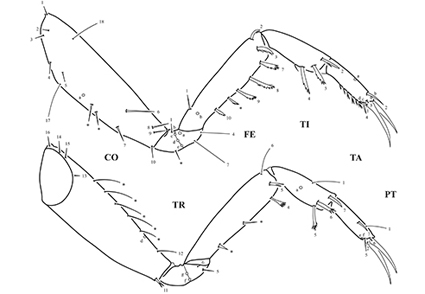Abstract
The second- and third-instar larvae of the diving-beetle species Hydrovatus crassulus Sharp, 1882 are described and illustrated, including detailed morphometric and chaetotaxic analyses of the cephalic capsule, head appendages, legs, last abdominal segment and urogomphi. Larvae of this species lack the parietal pore PAo, the premental seta LA3 and the urogomphal seta UR8, and have the sensillum MN2 shaped as a short hair-like seta and the ventral surface of the abdominal segments II–V sclerotized. All these characteristics are shared with the other species of Hydrovatus Motschulsky, 1853 known in detail (H. caraibus Sharp, 1882) and therefore are considered diagnostic for the genus. Hydrovatus crassulus also characterizes by the presence of a small galea, which reinforces the hypothesis that this structure is part of the ancestral condition of Hydrovatus. Larvae of H. crassulus differ from those of H. caraibus in having a smaller size, a smaller ratio U/LAS, and a larger ratio U1/U2, and also in the presence (in most cases) of a secondary seta on the anteroventral surface of femur.
References
Alarie, Y. (1991) Primary setae and pores on the cephalic capsule and head appendages of larval Hydroporinae (Coleoptera: Dytiscidae: Hydroporinae). Canadian Journal of Zoology, 69, 2255–2265. https://doi.org/10.1139/z91-316
Alarie, Y. & Harper, P.P. (1990) Primary setae and pores on the last abdominal segment and the urogomphi of larval Hydroporinae (Coleoptera: Adephaga: Dytiscidae), with notes on other dytiscid larvae. Canadian Journal of Zoology, 68, 368–374. https://doi.org/10.1139/z90-052
Alarie, Y., Harper, P.P. & Maire, A. (1990) Primary setae and pores on legs of larvae of Nearctic Hydroporinae (Coleoptera: Dytiscidae). Quaestiones Entomologicae, 26, 199–210.
Alarie, Y. & Michat, M.C. (2007a) Primary setae and pores on the maxilla of larvae of the subfamily Hydroporinae (Coleoptera: Adephaga: Dytiscidae): ground plan pattern reconsidered. The Coleopterists Bulletin, 61, 310–317. https://doi.org/10.1649/0010-065X(2007)61[310:PSAPOT]2.0.CO;2
Alarie, Y. & Michat, M.C. (2007b) Phylogenetic analysis of Hydroporinae (Coleoptera: Dytiscidae) based on larval morphology, with description of first instar of Laccornellus lugubris. Annals of the Entomological Society of America, 100, 655–665. https://doi.org/10.1603/0013-8746(2007)100[655:PAOHCD]2.0.CO;2
Biström, O. (1997) Taxonomic Revision of the genus Hydrovatus Motschulsky (Coleoptera, Dytiscidae). Entomologica Basiliensia, 19, 57–584.
Libonatti, M.L., Michat, M.C. & Torres, P.L.M. (2013) Aquatic Coleoptera from two protected areas of the Humid Chaco eco-region (Chaco Province, Argentina). Revista de la Sociedad Entomológica Argentina, 72, 155–168.
Michat, M.C. (2006) The phylogenetic position of Hydrovatus Motschulsky: evidence from larval morphology of H. caraibus Sharp (Coleoptera: Dytiscidae: Hydroporinae). Insect Systematics & Evolution, 37, 419–432. https://doi.org/10.1163/187631206788831416
Michat, M.C., Alarie, Y., Torres, P.L.M. & Megna, Y.S. (2007) Larval morphology of the diving beetle Celina and the phylogeny of ancestral hydroporines (Coleoptera: Dytiscidae: Hydroporinae). Invertebrate Systematics, 21, 239–254. https://doi.org/10.1071/IS06037
Michat, M.C., Alarie, Y. & Miller, K.B. (2017) Higher-level phylogeny of diving beetles (Coleoptera: Dytiscidae) based on larval characters. Systematic Entomology, 42, 734–767. https://doi.org/10.1111/syen.12243
Miller, K.B. & Bergsten, J. (2016) Diving beetles of the world. Systematics and biology of the Dytiscidae. Johns Hopkins University Press, Baltimore, Maryland, 320 pp.
Nilsson, A.N. & Hájek, J. (2021) A world catalogue of the family Dytiscidae, or the diving beetles (Coleoptera, Adephaga). Version 1.I.2021. Distributed as a PDF file via Internet. Available from: http://www.waterbeetles.eu (accessed 22 May 2021)
Trémouilles, E.R., Michat, M.C. & Torres, P.L.M. (2005) A synopsis of the South American Hydrovatus (Coleoptera: Dytiscidae: Hydroporinae), with notes on habitat and distribution, and a key to species. Revista de la Sociedad Entomológica Argentina, 64, 61–69.
Wiley, E.O. (1981) Phylogenetics. The theory and practice of phylogenetic systematics. John Wiley and Sons, New York, New York, 439 pp.
Wolfe, G.W. (1985) A phylogenetic analysis of plesiotypic Hydroporinae lineages with an emphasis on Laccornis Des Gozis (Coleoptera: Dytiscidae). Proceedings of the Academy of Natural Sciences of Philadelphia, 137, 132–155.
Wolfe, G.W. (1988) A phylogenetic investigation of Hydrovatus, Methlini and other plesiotypic hydroporines (Coleoptera: Dytiscidae). Psyche, 95, 61–71. https://doi.org/10.1155/1988/17890


